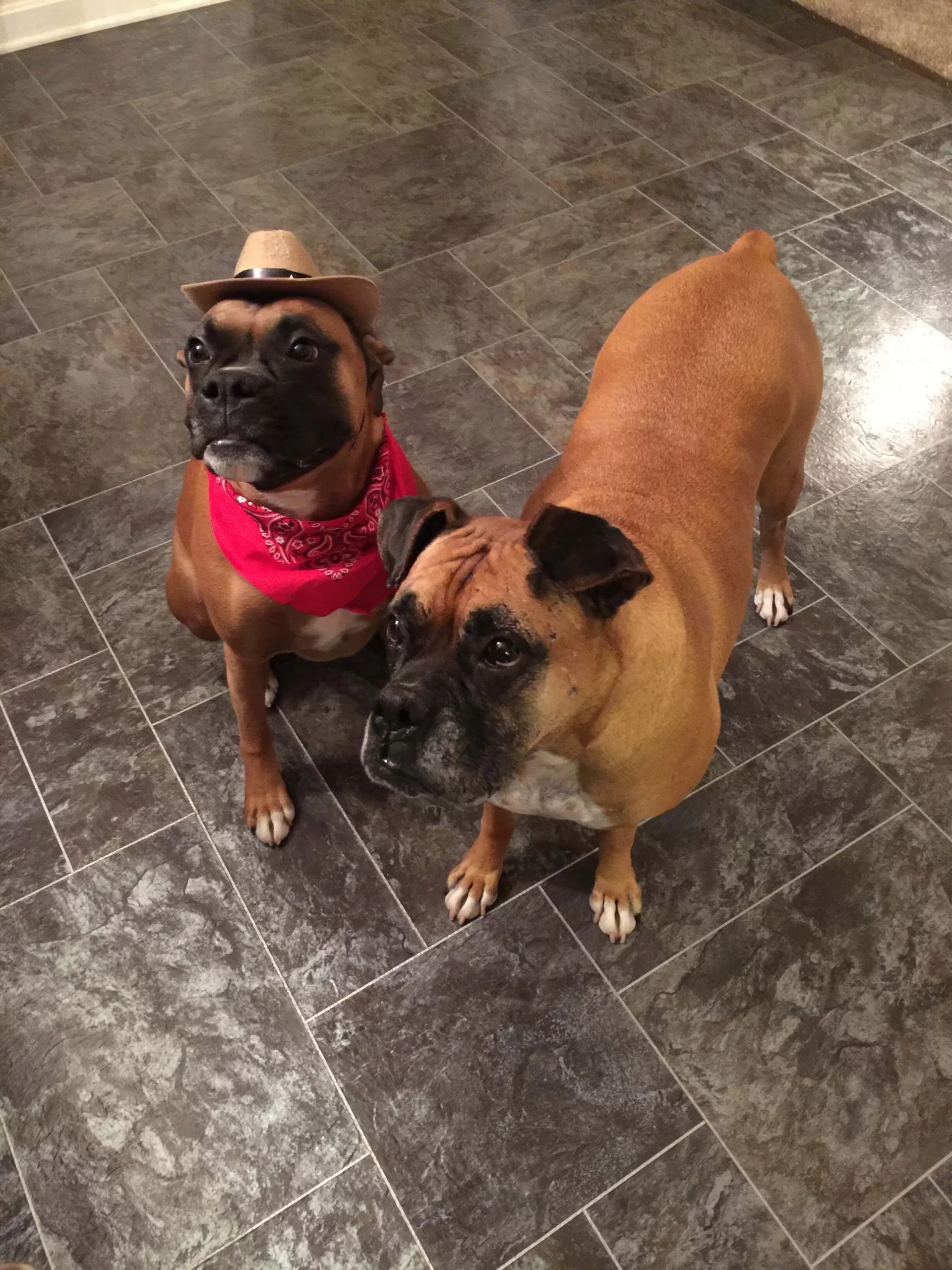This post contains affiliate links. See our Affiliate Disclosure Statement page for more details.
Table of Contents
Common Boxer Dog Behavior Issues
Boxers are playful, high-energy, loyal family dogs. These characteristics are what Boxer owners love about their pets.
However, these characteristics can also lead to unwanted behavior issues if not properly channeled. This article identifies 3 common Boxer Dog behavior issues and provides practical solutions for having a well-behaved Boxer dog.
3 Common Boxer Dog Behavior Issues
All dogs have behavior issues inherent to their breed. Boxer dogs are no exception and demonstrate unwanted behavior issues when not properly trained and socialized. The 3 most commonly observed Boxer dog behavior issues are
- Jumping
- Barking
- Chewing
Let’s look at each behavior issue in more detail and then provide proven solutions and strategies to prevent these issues for a well-behaved Boxer dog.
Boxer Dog Behavior Issues – Jumping
Jumping is a common behavior issue that many Boxer owners face.
Boxers are enthusiastic and energetic dogs, and jumping can be a way for them to express their excitement and greet their owners. However, jumping can become problematic when it becomes excessive or is directed toward guests or strangers.
Training Techniques for Reducing Jumping Behavior
- Sit on Command
- Ignore Your Jumping Boxer
Sit on Command

Sit on Command can be accomplished through positive reinforcement training, where you reward your dog for exhibiting the desired behavior.
To train your Boxer to sit, start by holding a treat above its head and moving it back towards its tail.
As they follow the treat, their natural response will be to sit down.
Reward them with the treat and verbal praise when they sit. Repeat this process until your Boxer sits on command without the need for a treat.
Ignoring A Jumping Boxer Dog
Another technique that can help reduce jumping behavior is to ignore your Boxer when they jump up.
Dogs often jump to get attention or seek interaction, and if you give them attention when they jump, you are reinforcing the behavior.
Instead, turn away from your dog when they jump and only give them attention and praise when they are sitting calmly.
The table below demonstrates the steps and procedures for training your Boxer not to jump
Boxer Dog Behavior – Steps for Training Your Boxer, not to Jump
| Step | Description | Products to Reinforce Behavior |
| 1 | Start with a calm environment, and make sure your dog is on a leash. | N/A |
| 2 | Encourage your dog to sit by saying “sit” and guiding them into a sitting position with a treat. | High-value treats, such as Pawstruck Yak Cheese Puffs or Blue Buffalo Bits |
| 3 | Once your dog is sitting, move a few steps away and then return to them. If they stay seated, give them a treat and praise them. | Control Ease Clicker from Cherrybrook and treats |
| 4 | If your dog tries to jump on you, turn your back and ignore them until they calm down. | Not Applicable |
| 5 | Repeat steps 2-4 until your dog consistently stays seated when you return to them. | Clicker and treats |
| 6 | Gradually increase the distractions in the environment, such as by having a friend walk by or by tossing a ball nearby. | Clicker and treats |
| 7 | If your dog tries to jump on you or the distraction, turn your back and ignore them until they calm down. | Not Applicable |
| 8 | Repeat steps 6-7 until your dog consistently stays seated even with distractions. | Clicker and treats |
| 9 | Once your dog has mastered sitting, you can start to incorporate other commands, such as “down” or “stay.” | Clicker and Treats |
| 10 | Practice regularly and be consistent with your training. | Not Applicable |
To learn more about the sit command, read our article Are Boxers Easy To Train? We Tested our Boxer’s Abilities to uncover the Answers
We use and recommend Blue Buffalo Blue Bits Soft Moist Training Dog Treats from Chewy.com
We use and recommend the training course Dog Commands for Beginners by Holly and Hugo
Boxer Dog Behavior – Barking

Boxers are known for being vocal dogs, and barking is a natural behavior for them.
However, excessive barking can become a problem, especially if it disturbs neighbors or causes issues in public spaces.
One effective solution to reduce excessive barking is to identify the cause of the behavior.
Boxers may bark out of
- Boredom
- Anxiety
- Alert owners of a perceived threat
Once you understand the underlying cause of the barking, you can take steps to address it.
For example, if your Boxer is barking out of boredom, provide them with toys and activities to keep them occupied.
Puzzle toys, chew toys, and interactive games can help keep your Boxer mentally stimulated and reduce their need to bark.
For Additional information on mental stimulation for your Boxer, read our article 9 Ways to Mentally Stimulate Your Boxer for a Happy Obedient Companion
We use and recommend the Starmark Treat Dispensing Chew Ball from Chewy and the Jolly Pets Tug and Toss Ball from Cherrybrook
If your Boxer is barking out of anxiety, consider consulting with a professional dog trainer or behaviorist to develop a behavior modification plan.
To help relieve anxiety try a sniff mat such as SAWYBISH Large Snuffle Mat for Dogs Foldable Dog Food Feeding Mat from Amazon
Try Pet CBD Soft Chews for Dogs to help your Boxer manage their anxiety available at Pet CBD
Another technique to reduce excessive barking is to teach your Boxer a “quiet” command.
When teaching your Boxer a new command it is important to provide positive feedback. Your Boxer wants to please you and by using positive reinforcement, you are also helping treat dependent command responses.
Start by waiting for your Boxer to bark and then say “quiet.” As soon as your Boxer stops barking, reward them with a treat and verbal praise.
Repeat this process until your Boxer learns to stop barking on command.
For more detailed information on Boxer Dogs Barking, read our article Do Boxer Dogs Bark A Lot? 4 Best Reasons Boxer Dogs Bark
The table below provides a summary of the different causes or triggers that cause Boxer dogs to bark along with the solutions and references for more details
Boxer dog Behavior – Barking Triggers
| Barking Trigger | Solution | References |
| Fear or anxiety | Socialization and training, desensitization, and counterconditioning techniques calming aids | Overall, K. L. (2013). Manual of clinical behavioral medicine for dogs and cats. Elsevier Health Sciences. [3] Landsberg, G., Hunthausen, W., & Ackerman, L. (2013). Behavior problems of the dog and cat. Elsevier Health Sciences. |
| Territorial behavior | Management strategies, training to control barking, providing mental stimulation | Pryor, K. (2019). Don’t Shoot the Dog: The New Art of Teaching and Training. Bantam. |
| Attention-seeking | Ignoring the barking, redirecting attention, positive reinforcement training | McLeod, S. A. (2018). Skinner-Operant Conditioning. Simply Psychology. |
| Boredom or lack of exercise | Increasing exercise and mental stimulation, interactive toys | Rohlf, V. I. (2018). What is your dog telling you? Good Dog Press. |
| Medical issues | Consulting with a veterinarian for diagnosis and treatment | Hsu, W. H., & Sun, L. (2010). Factors associated with aggressive responses in pet dogs. Journal of Veterinary Behavior: Clinical Applications and Research, 5(6), 363-373. |
Boxer Dog Behavior – Chewing

Chewing is a natural behavior for dogs, and it is essential for their dental health and mental stimulation.
However, if your Boxer is chewing on inappropriate items, such as furniture or shoes, it can become a problem.
One effective solution to reduce inappropriate chewing is to provide your Boxer with plenty of appropriate chew toys.
Choose toys that are durable and safe for your dog to chew on, such as Kong toys, rope toys, or nylon bones.
Rotate the toys regularly to keep your Boxer interested and engaged.
Another technique to reduce inappropriate chewing is to teach your Boxer the “leave it” command. Use Treats and positive responses to reinforce the command.
Start by holding a treat in your hand and saying “leave it.”
When your Boxer stops trying to get the treat, reward them with a different treat and verbal praise. Repeat this process until your Boxer learns to leave objects alone on command.
The table below outlines the common reasons Boxers chew, along with solutions to prevent destructive chewing and recommended products to help prevent chewing.
Boxer Dog Behavior – Reasons Boxers Chew
| Reasons Why Boxers Chew | Solutions | Recommended Products |
| Boredom or anxiety | Provide plenty of exercises and mental stimulation, such as puzzle toys or interactive games. Consider hiring a dog walker or using a dog daycare service | Kong Classic Dog Toy, Nylabone Power Chew Dura Chew Textured Ring, Outward Hound Nina Ottosson Dog Tornado Puzzle Toy |
| Teething or dental issues | Provide appropriate chew toys that are safe and durable. Consider regular dental check-ups and cleanings | Nylabone Puppy Chew Toys, Benebone Real Flavor Dental Chew, Greenies Dental Chews |
| Hunger or thirst | Ensure that your dog has access to fresh water and is fed at regular intervals | PetSafe Healthy Pet Water Station, Outward Hound Fun Feeder Slo-Bowl, PetSafe Simply Feed Automatic Feeder |
| Lack of training or supervision | Train your dog to understand what is and isn’t acceptable to chew on. Provide supervision and redirect their attention when necessary. | Kong Puppy Toy, Bitter Apple Spray, Outward Hound Hide-A-Squirrel Puzzle Toy |
| Attention-seeking behavior | Avoid giving your dog attention when they chew on inappropriate objects. Provide attention and praise when they chew on appropriate objects. | Nylabone Power Chew Flavored Chew Toy, Chuckit! Ultra Ball, KONG Extreme Dog Toy |
If your dog is chewing because of boredom, we use and recommend the Kong Classic Dog Toy available at Cherrybrook
If your Boxer is chewing because of Teething or Dental Issues, we recommend Purina DentaLife Daily Oral Care Treats from Chewy.com
Attention Seeking Behavior, we recommend the Chuck It Fumble Fetch Ball available at Cherrybrook
Boxer Dog Behavior – Summary of Issues and Solutions
| Issue | Solution | Products to Support Training | Frequency of Training |
| Biting | Redirect the dog’s attention to a chew toy or bone whenever it tries to bite | Chew toys, bones | Daily |
| Jumping on people | Ignore the dog when it jumps and only give it attention when it has all four paws on the ground | Treats, verbal praise | Daily |
| Chewing on household items | Provide the dog with appropriate chew toys and make sure it has plenty of exercises and mental stimulation | Chew toys, puzzle toys | Daily |
| Separation anxiety | Gradually desensitize the dog to being alone and provide it with a safe space or crate to retreat to | Treats, calming pheromone sprays, anxiety supplements | Daily |
| Pulling on the leash during walks | Use a no-pull harness or head collar and train the dog to walk politely on a loose leash | No-pull harnesses, head collars, training treats | 2-3 times per week |
| Aggression toward other dogs | Seek the help of a professional dog trainer and gradually introduce the dog to other dogs in a controlled setting | Professional dog trainer, muzzle | As needed |
| Excessive barking | Teach the dog to be quiet on command and provide it with plenty of exercises and mental stimulation | Training treats, verbal praise | Daily |
| Digging | Provide the dog with an appropriate digging area and make sure it has plenty of exercises and mental stimulation | Sandpit, a digging box, puzzle toys | Daily |
Boxer Dog Behavior – Summary
In conclusion, Boxer dogs are a wonderful breed known for their loyalty, energy, and playful nature.
However, they are not without their challenges. If you own a Boxer or are considering getting one, it is important to be aware of some of the common behavior issues that they may exhibit.
By understanding the root causes of these behaviors and implementing the appropriate solutions and training techniques, you can help your Boxer become a well-behaved and happy member of your family.
Remember that training is an ongoing process and requires patience, consistency, and positive reinforcement.
Whether it’s biting, jumping, chewing, or any other behavior issue, there is always a solution that can help your Boxer overcome it. With the right approach and dedication, you can build a strong bond with your Boxer and enjoy many happy years together.
So, take the time to learn about your Boxer dog behavior, and with proper training and attention, you can raise a happy, healthy, and well-behaved Boxer dog.

Discoverboxerdogs.com are Mary and Chris Kustanbauter. We reside in Red Lion, PA with our two Boxers, Duke and Katie, who are both rescue dogs. We have been working with Adopt A Boxer Rescue for the past 17 years and have adopted 5 Boxers from this fine organization. To learn more visit our Home, About Us, and Blogs Pages Visit us on social media on Facebook – All About Boxers, Instagram, and Pinterest

